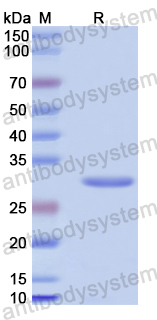Catalog No.
YHK95501
Expression system
E. coli
Species
Homo sapiens (Human)
Protein length
Ser1764-Ile2010
Predicted molecular weight
30.05 kDa
Nature
Recombinant
Endotoxin level
Please contact with the lab for this information.
Purity
>90% as determined by SDS-PAGE.
Accession
Q8TEP8
Applications
ELISA, Immunogen, SDS-PAGE, WB, Bioactivity testing in progress
Form
Lyophilized
Storage buffer
Lyophilized from a solution in PBS pH 7.4, 0.02% NLS, 1mM EDTA, 4% Trehalose, 1% Mannitol.
Reconstitution
Reconstitute in sterile water for a stock solution. A copy of datasheet will be provided with the products, please refer to it for details.
Shipping
In general, proteins are provided as lyophilized powder/frozen liquid. They are shipped out with dry ice/blue ice unless customers require otherwise.
Stability and Storage
Use a manual defrost freezer and avoid repeated freeze thaw cycles. Store at 2 to 8°C for frequent use. Store at -20 to -80°C for twelve months from the date of receipt.
Alternative Names
CEP192, Cep192, Cep192/SPD-2, Centrosomal protein of 192 kDa, KIAA1569
Glutamylation of centrosomes ensures their function by recruiting microtubule nucleation factors., PMID:40229407
PLK4 Homodimerization is Required for CEP152 Centrosome Localization and Spindle Organization., PMID:40222413
Synthesis of an RBM39 Degrader That Downregulates CEP192 and Induces Disorganized Spindle Structures., PMID:40107850
The conserved Spd-2/CEP192 domain adopts a unique protein fold to promote centrosome scaffold assembly., PMID:40106572
Rapid and sustained degradation of the essential centrosome protein CEP192 in live mice using the AID2 system., PMID:40020058
Centrioles generate two scaffolds with distinct biophysical properties to build mitotic centrosomes., PMID:39919171
[CEP192 overexpression is correlated with poor prognosis of gastric cancer and promotes gastric cancer cell proliferation by regulating PLK1/CDK1/Cyclin B1 signaling]., PMID:39623269
Brain multi-omic Mendelian randomisation to identify novel drug targets for gliomagenesis., PMID:39565278
CEP192 localises mitotic Aurora-A activity by priming its interaction with TPX2., PMID:39327527
Spermatocytes have the capacity to segregate chromosomes despite centriole duplication failure., PMID:38943004
The AID2 system offers a potent tool for rapid, reversible, or sustained degradation of essential proteins in live mice., PMID:38895390
Centrosomal protein of 192 kDa (Cep192) fragment possesses bactericidal and parasiticidal activities in Larimichthys crocea., PMID:38287570
Dual roles of CCDC102A in governing centrosome duplication and cohesion., PMID:38280197
Mosaic variegated aneuploidy syndrome with tetraploid, and predisposition to male infertility triggered by mutant CEP192., PMID:37981762
Centrosomal organization of Cep152 provides flexibility in Plk4 and procentriole positioning., PMID:37707473
Hornerin mediates phosphorylation of the polo-box domain in Plk1 by Chk1 to induce death in mitosis., PMID:37596441
Structural basis for CEP192-mediated regulation of centrosomal AURKA., PMID:37083534
SH2D4A promotes centrosome maturation to support spindle microtubule formation and mitotic progression., PMID:36739326
A Human Hereditary Cardiomyopathy Shares a Genetic Substrate With Bicuspid Aortic Valve., PMID:36325906
CEP192 is a novel prognostic marker and correlates with the immune microenvironment in hepatocellular carcinoma., PMID:36238304
Self-assembly of pericentriolar material in interphase cells lacking centrioles., PMID:35787744
A combined in silico and in vivo approach to the structure-function annotation of SPD-2 provides mechanistic insight into its functional diversity., PMID:35678569
Centrioles generate a local pulse of Polo/PLK1 activity to initiate mitotic centrosome assembly., PMID:35505659
Structural validation and assessment of AlphaFold2 predictions for centrosomal and centriolar proteins and their complexes., PMID:35383272
TRIM37: a critical orchestrator of centrosome function., PMID:34672905
Cep192, a Novel Missing Link between the Centrosomal Core and Corona in Dictyostelium Amoebae., PMID:34572033
Triple deletion of TP53, PCNT, and CEP215 promotes centriole amplification in the M phase., PMID:34233584
Centriole-less pericentriolar material serves as a microtubule organizing center at the base of C. elegans sensory cilia., PMID:33798428
Centriole and PCM cooperatively recruit CEP192 to spindle poles to promote bipolar spindle assembly., PMID:33443571
A novel mitosis-specific Cep215 domain interacts with Cep192 and phosphorylated Aurora A for organization of spindle poles., PMID:33376154
TRIM37 controls cancer-specific vulnerability to PLK4 inhibition., PMID:32908304
Identification of genes in hepatocellular carcinoma induced by non-alcoholic fatty liver disease., PMID:32623384
Drosophila Sas-6, Ana2 and Sas-4 self-organise into macromolecular structures that can be used to probe centriole and centrosome assembly., PMID:32409564
Differential Requirements for Centrioles in Mitotic Centrosome Growth and Maintenance., PMID:31303441
Atypical function of a centrosomal module in WNT signalling drives contextual cancer cell motility., PMID:31142743
Acentriolar microtubule organization centers and Ran-mediated microtubule formation pathways are both required in porcine oocytes., PMID:31136049
Protein Hydroxylation by Hypoxia-Inducible Factor (HIF) Hydroxylases: Unique or Ubiquitous?, PMID:31035491
Bridging centrioles and PCM in proper space and time., PMID:30429283
The dual role of the centrosome in organizing the microtubule network in interphase., PMID:30224411
Aurora-PLK1 cascades as key signaling modules in the regulation of mitosis., PMID:30108183
Centrosomal ALIX regulates mitotic spindle orientation by modulating astral microtubule dynamics., PMID:29858227
CDK5RAP2 Is an Essential Scaffolding Protein of the Corona of the Dictyostelium Centrosome., PMID:29690637
FBXL13 directs the proteolysis of CEP192 to regulate centrosome homeostasis and cell migration., PMID:29348145
Distinct roles of Cep192 and Cep152 in acentriolar MTOCs and spindle formation during mouse oocyte maturation., PMID:28970258
CIP2A acts as a scaffold for CEP192-mediated microtubule organizing center assembly by recruiting Plk1 and aurora A during meiotic maturation., PMID:28935709
The DNA replication protein Cdc6 inhibits the microtubule-organizing activity of the centrosome., PMID:28827311
Recruitment of PP1 to the centrosomal scaffold protein CEP192., PMID:28188792
Centriolar SAS-7 acts upstream of SPD-2 to regulate centriole assembly and pericentriolar material formation., PMID:28092264
A FRET biosensor reveals spatiotemporal activation and functions of aurora kinase A in living cells., PMID:27624869
Cep295 is a conserved scaffold protein required for generation of a bona fide mother centriole., PMID:27562453

